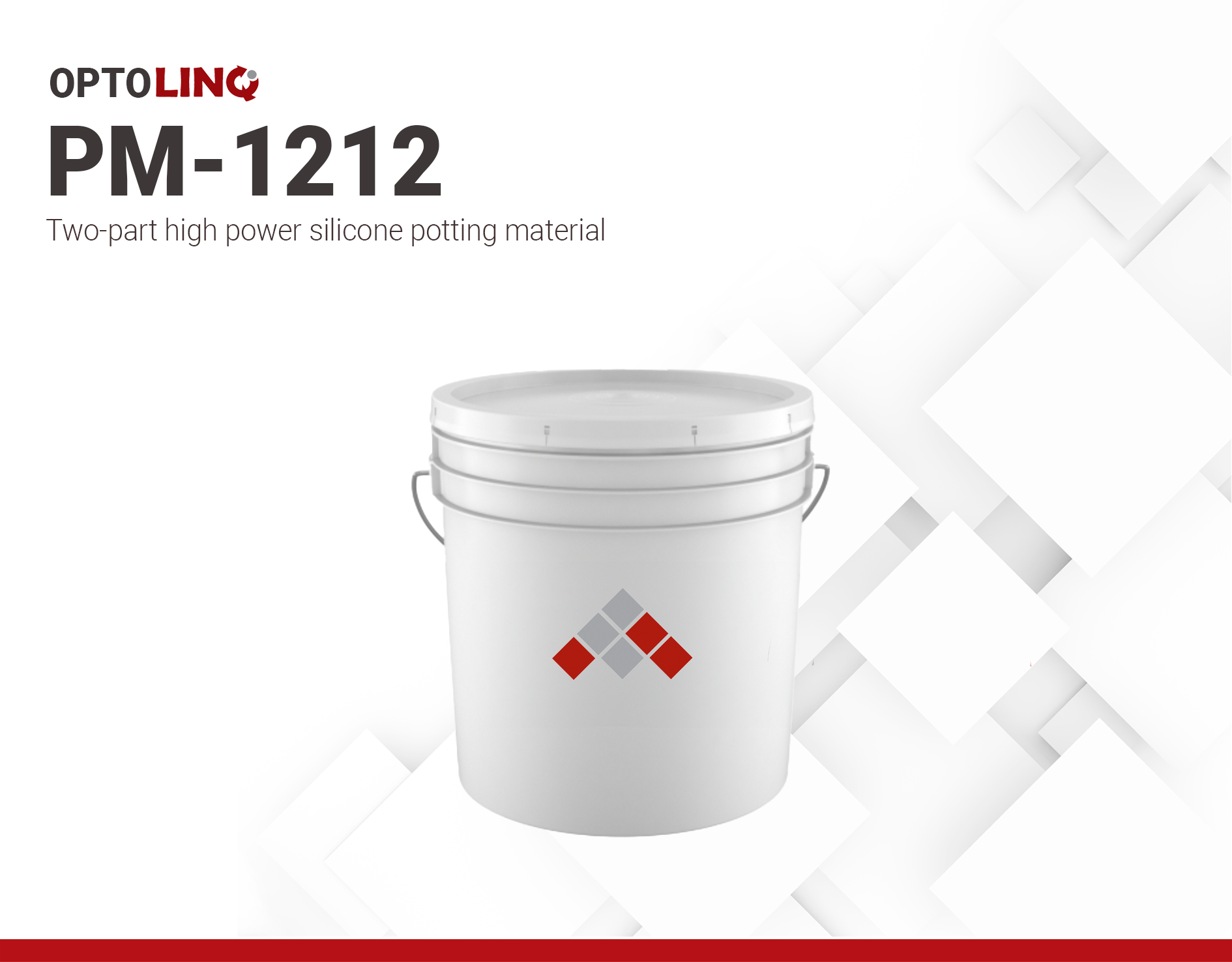OPTOLINQ PM-1212 | Two-part silicone potting
- High optical transparency
- Excellent UV and thermal resistance
- Excellent adhesion to different materials
Product Description
OPTOLINQ PM-1212 is a two-part, high-performance silicone potting compound designed for demanding optoelectronic applications. With excellent thermal resistance and high optical transparency, it provides reliable encapsulation for a variety of high-power LED modules. Its superior UV and thermal stability ensures long-term durability.
OPTOLINQ PM-1212 exhibits excellent adhesion to a wide range of materials and is suitable for diverse package configurations requiring good shape control. This material is optimized for high-power applications, including automotive lighting and high-power backlighting systems. It is an ideal choice for industries seeking reliability, peak performance, and processability.
Technical Specifications
| General Properties | |||||
| Appearance Appearance Appearance at room temperature. | Transparent | ||||
| Mix Ratio Mix Ratio The amount of a constituent divided by the total amount of all other constituents in a mixture | 1:10 | ||||
| Pot Life Pot Life Pot life is the amount of time it takes for the viscosity of a material to double (or quadruple for lower viscosity materials) in room temperature after a material is mixed. It is closely related to work life but it is not application dependent, less precise and more of a general indication of how fast a system is going to cure. | 5 hours | ||||
| Refractive index Refractive index The refractive index determines how much the path of light is bent, or refracted, when entering a material. It is calculated by taking into account the velocity of light in vacuum compared to the velocity of light in the material. The refractive index calculation can be affected by the wavelength of light and the temperature of the material. Even though it is usually reported on standard wavelengths it is advised to check the TDS for the precise test parameters. | 1.41 | ||||
| |||||
| Physical Properties | |||||
| Viscosity Viscosity Viscosity is a measurement of a fluid’s resistance to flow. Viscosity is commonly measured in centiPoise (cP). One cP is defined as the viscosity of water and all other viscosities are derived from this base. MPa is another common unit with a 1:1 conversion to cP. A product like honey would have a much higher viscosity -around 10,000 cPs- compared to water. As a result, honey would flow much slower out of a tipped glass than water would. The viscosity of a material can be decreased with an increase in temperature in order to better suit an application | 1100 mPa.s | ||||
| Mechanical Properties | |||||
| |||||
| Elongation Elongation Elongation is the process of lengthening something. It is a percentage that measures the initial, unstressed, length compared to the length of the material right before it breaks. It is commonly referred to as Ultimate Elongation or Tensile Elongation at break. | 45 % | ||||
Additional Information
Processing Instructions
Mix Parts A and B in a 1:10 weight ratio. Ensure that the mixture is uniform and free from streaks or unevenness.
Defoam the mixture under vacuum.
Typical curing conditions: First cure at 60-80°C for 1 hour, followed by post cure at 150°C for 3h.
Precautions
Addition-cure materials may be susceptible to inhibition by certain substances, including organotin and other organometallic compounds, silicone rubber with organotin catalyst, sulfur-containing materials such as polysulfones, amines, urethanes, amine-containing materials, unsaturated hydrocarbon plasticizers, and some solder flux residues. Always exercise caution and conduct thorough compatibility testing when encountering materials or chemicals of concern in your specific application to prevent potential curing issues.
Avoid skin and eye contact. In case of contact, rinse thoroughly with soap (for skin) or clean water (for eyes), and seek medical attention if needed.
Maintain a clean and ventilated workplace, using extraction trunks when necessary.
Wear appropriate protective equipment and minimize direct contact with the human body. Refer to the Safety Data Sheet (SDS) before use.
Please note that the provided information is based on available data and typical conditions. For specific applications and detailed test results, refer to the actual test data and conduct appropriate certifications.
Cleaning
Uncured silicone can be easily removed using acetone or xylene. Polar solvents, including water and alcohols, are not recommended for cleaning.
Storage and Handling
Store in a ventilated, dry, and clean environment below 25°C. Do not allow moisture to come into contact with these materials. Containers should always remain tightly sealed. For partially filled containers, it is recommended to purge them with dry air or inert gases like nitrogen to maintain product integrity. At proper storage conditions, Part A and B have a shelf life of 6 months.



